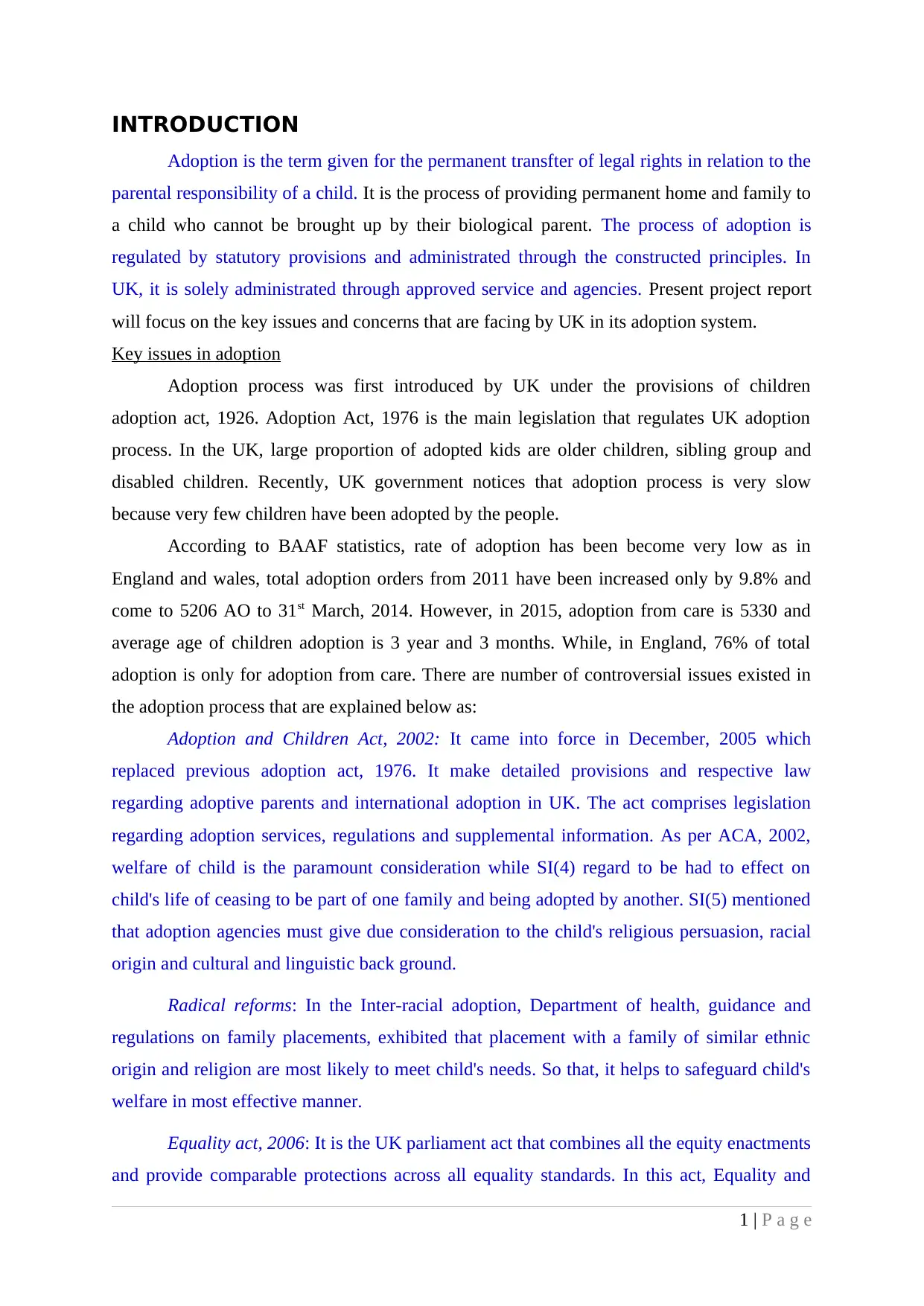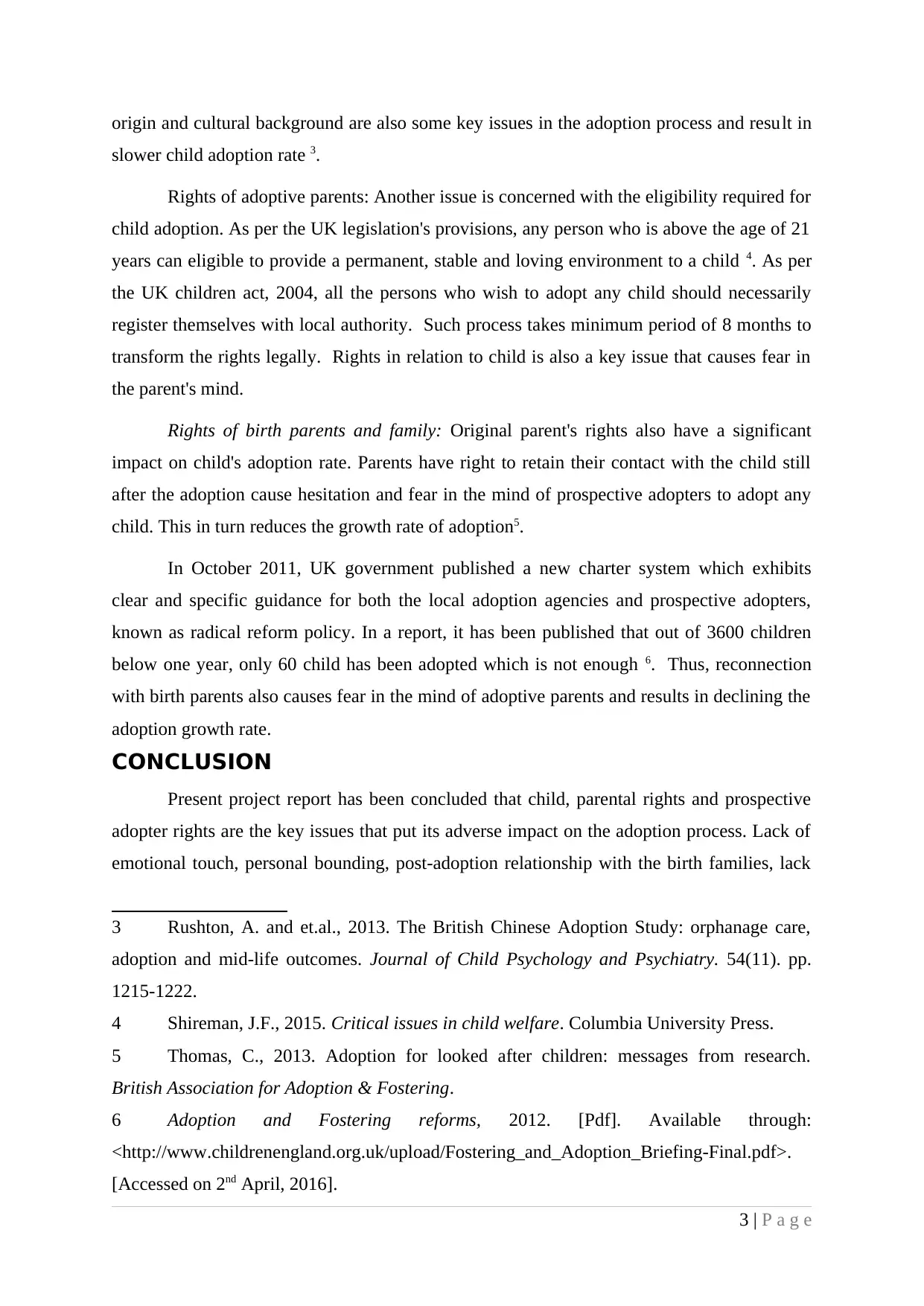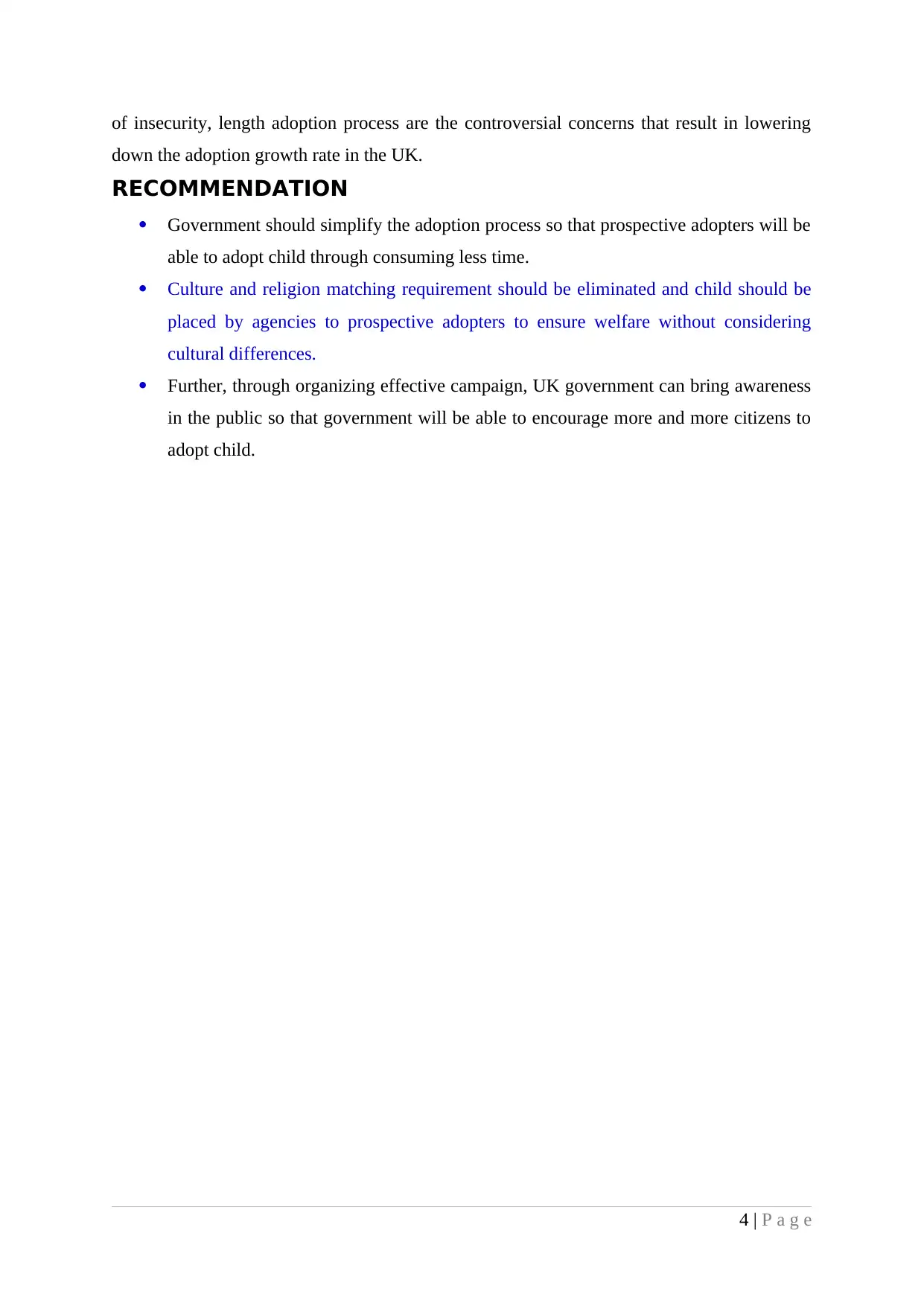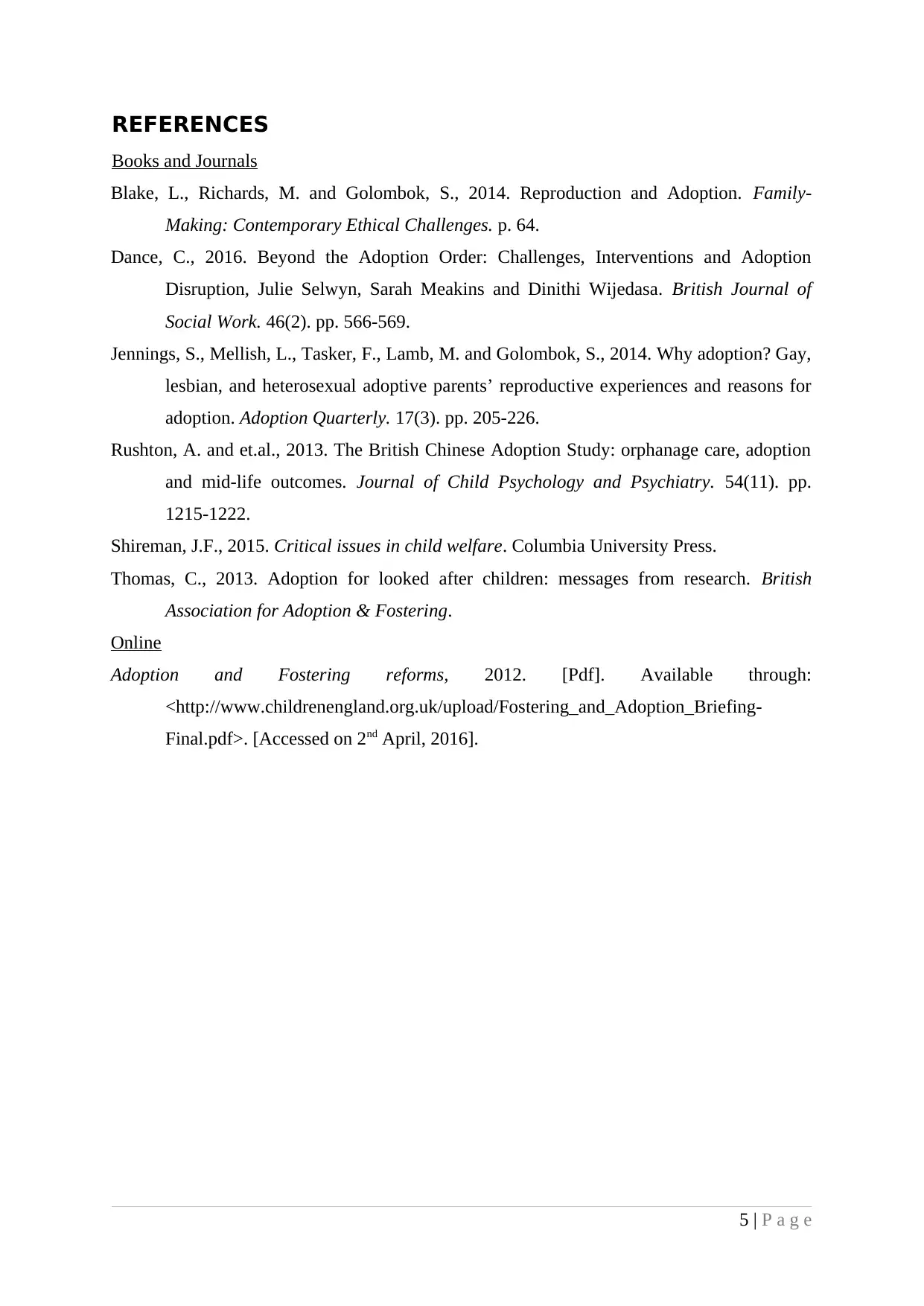Comprehensive Report on Key Issues in the UK Adoption System
VerifiedAdded on 2020/01/21
|7
|1835
|208
Report
AI Summary
This report provides an overview of the key issues and challenges in the UK adoption system. It begins with an introduction to adoption, defining the process and its legal framework. The report then delves into critical issues, including the Adoption and Children Act 2002, radical reforms, and the Equality Act 2006. It also explores the rights of children, adoptive parents, and birth parents, highlighting the complexities and controversies surrounding these rights. The report further examines the Children and Families Act 2014 and its impact on the adoption process. The conclusion summarizes the key findings, emphasizing the impact of children's rights, parental rights, and prospective adopter rights on adoption rates. Finally, the report offers recommendations for simplifying the adoption process and promoting public awareness. The report utilizes various sources to support its arguments and analysis.

ADOPTION
Paraphrase This Document
Need a fresh take? Get an instant paraphrase of this document with our AI Paraphraser

Table of Contents
INTRODUCTION......................................................................................................................1
Key issues in adoption......................................................................................................1
CONCLUSION..........................................................................................................................3
RECOMMENDATION.............................................................................................................3
REFERENCES...........................................................................................................................4
INTRODUCTION......................................................................................................................1
Key issues in adoption......................................................................................................1
CONCLUSION..........................................................................................................................3
RECOMMENDATION.............................................................................................................3
REFERENCES...........................................................................................................................4

INTRODUCTION
Adoption is the term given for the permanent transfter of legal rights in relation to the
parental responsibility of a child. It is the process of providing permanent home and family to
a child who cannot be brought up by their biological parent. The process of adoption is
regulated by statutory provisions and administrated through the constructed principles. In
UK, it is solely administrated through approved service and agencies. Present project report
will focus on the key issues and concerns that are facing by UK in its adoption system.
Key issues in adoption
Adoption process was first introduced by UK under the provisions of children
adoption act, 1926. Adoption Act, 1976 is the main legislation that regulates UK adoption
process. In the UK, large proportion of adopted kids are older children, sibling group and
disabled children. Recently, UK government notices that adoption process is very slow
because very few children have been adopted by the people.
According to BAAF statistics, rate of adoption has been become very low as in
England and wales, total adoption orders from 2011 have been increased only by 9.8% and
come to 5206 AO to 31st March, 2014. However, in 2015, adoption from care is 5330 and
average age of children adoption is 3 year and 3 months. While, in England, 76% of total
adoption is only for adoption from care. There are number of controversial issues existed in
the adoption process that are explained below as:
Adoption and Children Act, 2002: It came into force in December, 2005 which
replaced previous adoption act, 1976. It make detailed provisions and respective law
regarding adoptive parents and international adoption in UK. The act comprises legislation
regarding adoption services, regulations and supplemental information. As per ACA, 2002,
welfare of child is the paramount consideration while SI(4) regard to be had to effect on
child's life of ceasing to be part of one family and being adopted by another. SI(5) mentioned
that adoption agencies must give due consideration to the child's religious persuasion, racial
origin and cultural and linguistic back ground.
Radical reforms: In the Inter-racial adoption, Department of health, guidance and
regulations on family placements, exhibited that placement with a family of similar ethnic
origin and religion are most likely to meet child's needs. So that, it helps to safeguard child's
welfare in most effective manner.
Equality act, 2006: It is the UK parliament act that combines all the equity enactments
and provide comparable protections across all equality standards. In this act, Equality and
1 | P a g e
Adoption is the term given for the permanent transfter of legal rights in relation to the
parental responsibility of a child. It is the process of providing permanent home and family to
a child who cannot be brought up by their biological parent. The process of adoption is
regulated by statutory provisions and administrated through the constructed principles. In
UK, it is solely administrated through approved service and agencies. Present project report
will focus on the key issues and concerns that are facing by UK in its adoption system.
Key issues in adoption
Adoption process was first introduced by UK under the provisions of children
adoption act, 1926. Adoption Act, 1976 is the main legislation that regulates UK adoption
process. In the UK, large proportion of adopted kids are older children, sibling group and
disabled children. Recently, UK government notices that adoption process is very slow
because very few children have been adopted by the people.
According to BAAF statistics, rate of adoption has been become very low as in
England and wales, total adoption orders from 2011 have been increased only by 9.8% and
come to 5206 AO to 31st March, 2014. However, in 2015, adoption from care is 5330 and
average age of children adoption is 3 year and 3 months. While, in England, 76% of total
adoption is only for adoption from care. There are number of controversial issues existed in
the adoption process that are explained below as:
Adoption and Children Act, 2002: It came into force in December, 2005 which
replaced previous adoption act, 1976. It make detailed provisions and respective law
regarding adoptive parents and international adoption in UK. The act comprises legislation
regarding adoption services, regulations and supplemental information. As per ACA, 2002,
welfare of child is the paramount consideration while SI(4) regard to be had to effect on
child's life of ceasing to be part of one family and being adopted by another. SI(5) mentioned
that adoption agencies must give due consideration to the child's religious persuasion, racial
origin and cultural and linguistic back ground.
Radical reforms: In the Inter-racial adoption, Department of health, guidance and
regulations on family placements, exhibited that placement with a family of similar ethnic
origin and religion are most likely to meet child's needs. So that, it helps to safeguard child's
welfare in most effective manner.
Equality act, 2006: It is the UK parliament act that combines all the equity enactments
and provide comparable protections across all equality standards. In this act, Equality and
1 | P a g e
⊘ This is a preview!⊘
Do you want full access?
Subscribe today to unlock all pages.

Trusted by 1+ million students worldwide

Human Rights Commission (EHRC) merged Commission for Racial Equality and Equal
Opportunities Commission and the Disability Rights Commission. It eliminates the
discrimination on goods and services on the ground of religion, belief, age, gender etc. In this
act, religion and belief was the anti-discrimination clauses. Thus, the act banned
discrimination in the provisions of services on the grounds of sexual orientation which
became a problem for Catholic adoption agencies.
Children and families Act, 2014: The act came into force in 2015 and contains a wide
range of laws and principles combines family law, children in care and education. As per the
act, contact between prescribed person and adopted persons relative, placement of kids with
their foster parents when they wish to adopt, waiting for court procedural, repeal of
requirement to give due consideration to ethnicity England and recruitment, assessment and
approval of prospective adopters have been made. One of the most important issue in this act
is length of time adoption as it takes a very long time in the adoption process due to legal
formalities.
Children's rights: One of the most significant reasons behind this is that children have
full right to contact with their biological parent and family. Moreover, it may be possible that
both the children and adoptive parents are of different culture and religious heritage. Thus, it
is a controversial issue that is faced by parents while they think to adopt any child 1. In the
United Kingdom, children have full rights to access information about their previous life
especially in relation to their original parents and arisen issues.
Human Rights Act and Department of Health review of adoption law demonstrate that
every child has right to respect his or her original identity in relation to their family, name
and nationality 2. Moreover, Article 8(1) of human rights tells that children have right that
they cannot be separated from their families against their will. In addition, Department of
Health, Guidance and Regulation on family placements entails that adoption agency may
place child for adoption so as to religious up-bringing. Thus, religious persuasion, racial
1 Dance, C., 2016. Beyond the Adoption Order: Challenges, Interventions and
Adoption Disruption, Julie Selwyn, Sarah Meakins and Dinithi Wijedasa. British Journal of
Social Work. 46(2). pp. 566-569.
2 Jennings, S., Mellish, L., Tasker, F., Lamb, M. and Golombok, S., 2014. Why
adoption? Gay, lesbian, and heterosexual adoptive parents’ reproductive experiences and
reasons for adoption. Adoption Quarterly. 17(3). pp. 205-226.
2 | P a g e
Opportunities Commission and the Disability Rights Commission. It eliminates the
discrimination on goods and services on the ground of religion, belief, age, gender etc. In this
act, religion and belief was the anti-discrimination clauses. Thus, the act banned
discrimination in the provisions of services on the grounds of sexual orientation which
became a problem for Catholic adoption agencies.
Children and families Act, 2014: The act came into force in 2015 and contains a wide
range of laws and principles combines family law, children in care and education. As per the
act, contact between prescribed person and adopted persons relative, placement of kids with
their foster parents when they wish to adopt, waiting for court procedural, repeal of
requirement to give due consideration to ethnicity England and recruitment, assessment and
approval of prospective adopters have been made. One of the most important issue in this act
is length of time adoption as it takes a very long time in the adoption process due to legal
formalities.
Children's rights: One of the most significant reasons behind this is that children have
full right to contact with their biological parent and family. Moreover, it may be possible that
both the children and adoptive parents are of different culture and religious heritage. Thus, it
is a controversial issue that is faced by parents while they think to adopt any child 1. In the
United Kingdom, children have full rights to access information about their previous life
especially in relation to their original parents and arisen issues.
Human Rights Act and Department of Health review of adoption law demonstrate that
every child has right to respect his or her original identity in relation to their family, name
and nationality 2. Moreover, Article 8(1) of human rights tells that children have right that
they cannot be separated from their families against their will. In addition, Department of
Health, Guidance and Regulation on family placements entails that adoption agency may
place child for adoption so as to religious up-bringing. Thus, religious persuasion, racial
1 Dance, C., 2016. Beyond the Adoption Order: Challenges, Interventions and
Adoption Disruption, Julie Selwyn, Sarah Meakins and Dinithi Wijedasa. British Journal of
Social Work. 46(2). pp. 566-569.
2 Jennings, S., Mellish, L., Tasker, F., Lamb, M. and Golombok, S., 2014. Why
adoption? Gay, lesbian, and heterosexual adoptive parents’ reproductive experiences and
reasons for adoption. Adoption Quarterly. 17(3). pp. 205-226.
2 | P a g e
Paraphrase This Document
Need a fresh take? Get an instant paraphrase of this document with our AI Paraphraser

origin and cultural background are also some key issues in the adoption process and result in
slower child adoption rate 3.
Rights of adoptive parents: Another issue is concerned with the eligibility required for
child adoption. As per the UK legislation's provisions, any person who is above the age of 21
years can eligible to provide a permanent, stable and loving environment to a child 4. As per
the UK children act, 2004, all the persons who wish to adopt any child should necessarily
register themselves with local authority. Such process takes minimum period of 8 months to
transform the rights legally. Rights in relation to child is also a key issue that causes fear in
the parent's mind.
Rights of birth parents and family: Original parent's rights also have a significant
impact on child's adoption rate. Parents have right to retain their contact with the child still
after the adoption cause hesitation and fear in the mind of prospective adopters to adopt any
child. This in turn reduces the growth rate of adoption5.
In October 2011, UK government published a new charter system which exhibits
clear and specific guidance for both the local adoption agencies and prospective adopters,
known as radical reform policy. In a report, it has been published that out of 3600 children
below one year, only 60 child has been adopted which is not enough 6. Thus, reconnection
with birth parents also causes fear in the mind of adoptive parents and results in declining the
adoption growth rate.
CONCLUSION
Present project report has been concluded that child, parental rights and prospective
adopter rights are the key issues that put its adverse impact on the adoption process. Lack of
emotional touch, personal bounding, post-adoption relationship with the birth families, lack
3 Rushton, A. and et.al., 2013. The British Chinese Adoption Study: orphanage care,
adoption and mid‐life outcomes. Journal of Child Psychology and Psychiatry. 54(11). pp.
1215-1222.
4 Shireman, J.F., 2015. Critical issues in child welfare. Columbia University Press.
5 Thomas, C., 2013. Adoption for looked after children: messages from research.
British Association for Adoption & Fostering.
6 Adoption and Fostering reforms, 2012. [Pdf]. Available through:
<http://www.childrenengland.org.uk/upload/Fostering_and_Adoption_Briefing-Final.pdf>.
[Accessed on 2nd April, 2016].
3 | P a g e
slower child adoption rate 3.
Rights of adoptive parents: Another issue is concerned with the eligibility required for
child adoption. As per the UK legislation's provisions, any person who is above the age of 21
years can eligible to provide a permanent, stable and loving environment to a child 4. As per
the UK children act, 2004, all the persons who wish to adopt any child should necessarily
register themselves with local authority. Such process takes minimum period of 8 months to
transform the rights legally. Rights in relation to child is also a key issue that causes fear in
the parent's mind.
Rights of birth parents and family: Original parent's rights also have a significant
impact on child's adoption rate. Parents have right to retain their contact with the child still
after the adoption cause hesitation and fear in the mind of prospective adopters to adopt any
child. This in turn reduces the growth rate of adoption5.
In October 2011, UK government published a new charter system which exhibits
clear and specific guidance for both the local adoption agencies and prospective adopters,
known as radical reform policy. In a report, it has been published that out of 3600 children
below one year, only 60 child has been adopted which is not enough 6. Thus, reconnection
with birth parents also causes fear in the mind of adoptive parents and results in declining the
adoption growth rate.
CONCLUSION
Present project report has been concluded that child, parental rights and prospective
adopter rights are the key issues that put its adverse impact on the adoption process. Lack of
emotional touch, personal bounding, post-adoption relationship with the birth families, lack
3 Rushton, A. and et.al., 2013. The British Chinese Adoption Study: orphanage care,
adoption and mid‐life outcomes. Journal of Child Psychology and Psychiatry. 54(11). pp.
1215-1222.
4 Shireman, J.F., 2015. Critical issues in child welfare. Columbia University Press.
5 Thomas, C., 2013. Adoption for looked after children: messages from research.
British Association for Adoption & Fostering.
6 Adoption and Fostering reforms, 2012. [Pdf]. Available through:
<http://www.childrenengland.org.uk/upload/Fostering_and_Adoption_Briefing-Final.pdf>.
[Accessed on 2nd April, 2016].
3 | P a g e

of insecurity, length adoption process are the controversial concerns that result in lowering
down the adoption growth rate in the UK.
RECOMMENDATION
Government should simplify the adoption process so that prospective adopters will be
able to adopt child through consuming less time.
Culture and religion matching requirement should be eliminated and child should be
placed by agencies to prospective adopters to ensure welfare without considering
cultural differences.
Further, through organizing effective campaign, UK government can bring awareness
in the public so that government will be able to encourage more and more citizens to
adopt child.
4 | P a g e
down the adoption growth rate in the UK.
RECOMMENDATION
Government should simplify the adoption process so that prospective adopters will be
able to adopt child through consuming less time.
Culture and religion matching requirement should be eliminated and child should be
placed by agencies to prospective adopters to ensure welfare without considering
cultural differences.
Further, through organizing effective campaign, UK government can bring awareness
in the public so that government will be able to encourage more and more citizens to
adopt child.
4 | P a g e
⊘ This is a preview!⊘
Do you want full access?
Subscribe today to unlock all pages.

Trusted by 1+ million students worldwide

REFERENCES
Books and Journals
Blake, L., Richards, M. and Golombok, S., 2014. Reproduction and Adoption. Family-
Making: Contemporary Ethical Challenges. p. 64.
Dance, C., 2016. Beyond the Adoption Order: Challenges, Interventions and Adoption
Disruption, Julie Selwyn, Sarah Meakins and Dinithi Wijedasa. British Journal of
Social Work. 46(2). pp. 566-569.
Jennings, S., Mellish, L., Tasker, F., Lamb, M. and Golombok, S., 2014. Why adoption? Gay,
lesbian, and heterosexual adoptive parents’ reproductive experiences and reasons for
adoption. Adoption Quarterly. 17(3). pp. 205-226.
Rushton, A. and et.al., 2013. The British Chinese Adoption Study: orphanage care, adoption
and mid‐life outcomes. Journal of Child Psychology and Psychiatry. 54(11). pp.
1215-1222.
Shireman, J.F., 2015. Critical issues in child welfare. Columbia University Press.
Thomas, C., 2013. Adoption for looked after children: messages from research. British
Association for Adoption & Fostering.
Online
Adoption and Fostering reforms, 2012. [Pdf]. Available through:
<http://www.childrenengland.org.uk/upload/Fostering_and_Adoption_Briefing-
Final.pdf>. [Accessed on 2nd April, 2016].
5 | P a g e
Books and Journals
Blake, L., Richards, M. and Golombok, S., 2014. Reproduction and Adoption. Family-
Making: Contemporary Ethical Challenges. p. 64.
Dance, C., 2016. Beyond the Adoption Order: Challenges, Interventions and Adoption
Disruption, Julie Selwyn, Sarah Meakins and Dinithi Wijedasa. British Journal of
Social Work. 46(2). pp. 566-569.
Jennings, S., Mellish, L., Tasker, F., Lamb, M. and Golombok, S., 2014. Why adoption? Gay,
lesbian, and heterosexual adoptive parents’ reproductive experiences and reasons for
adoption. Adoption Quarterly. 17(3). pp. 205-226.
Rushton, A. and et.al., 2013. The British Chinese Adoption Study: orphanage care, adoption
and mid‐life outcomes. Journal of Child Psychology and Psychiatry. 54(11). pp.
1215-1222.
Shireman, J.F., 2015. Critical issues in child welfare. Columbia University Press.
Thomas, C., 2013. Adoption for looked after children: messages from research. British
Association for Adoption & Fostering.
Online
Adoption and Fostering reforms, 2012. [Pdf]. Available through:
<http://www.childrenengland.org.uk/upload/Fostering_and_Adoption_Briefing-
Final.pdf>. [Accessed on 2nd April, 2016].
5 | P a g e
1 out of 7
Related Documents
Your All-in-One AI-Powered Toolkit for Academic Success.
+13062052269
info@desklib.com
Available 24*7 on WhatsApp / Email
![[object Object]](/_next/static/media/star-bottom.7253800d.svg)
Unlock your academic potential
Copyright © 2020–2025 A2Z Services. All Rights Reserved. Developed and managed by ZUCOL.





